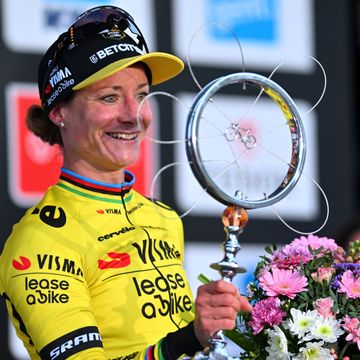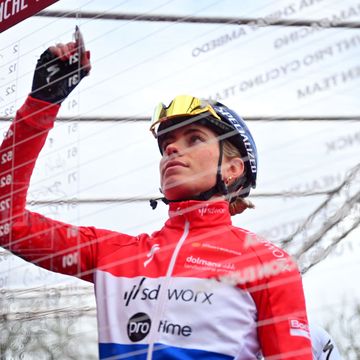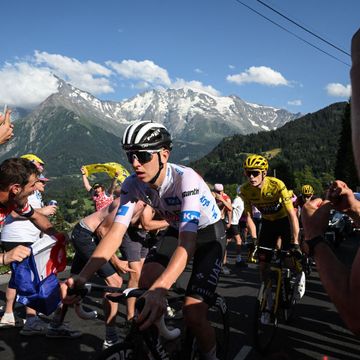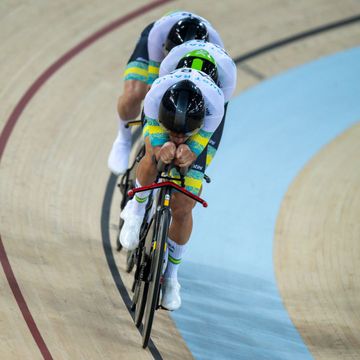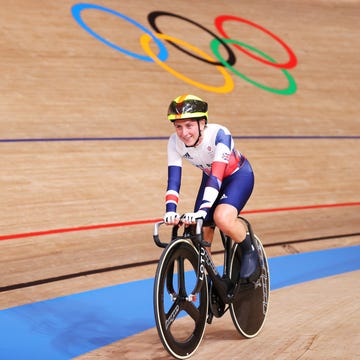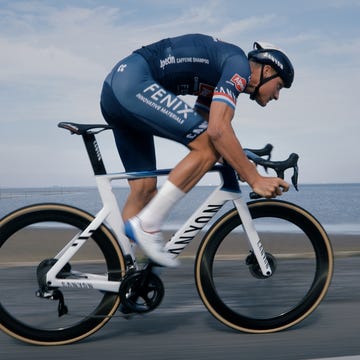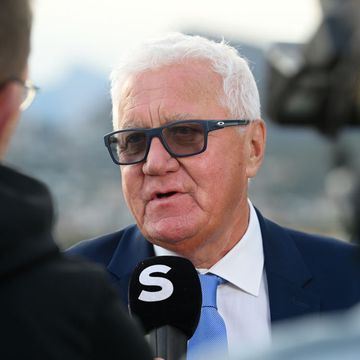Pedaling side by side, my wife, Sue Ibarra, and I are part of wave after wave of cyclists that take up the entire 12-mile stretch of the main street, Carrera Séptima, in downtown Bogotá, Colombia.
An old man in a serape on a bright-red 1970s Sting-Ray spins alongside us, grinning beneath a yellow helmet. We split to pass around a four-year-old, fingers barely reaching the brakes, seated on a teeny orange bike with training wheels. An ex-Colombian racer, now in his '60s, riding a sleek, steel-frame Italian road bike and wearing a yellow, blue, and red woolen team jersey, whizzes past us. Three young women in running shoes pump along together on cheap mountain bikes, seats all too low, chatting and giggling. A man on an ancient Dutch bike. Two city hipsters on fixies painted screaming orange.
Carrera Séptima bisects the financial district, the commercial district, and the government sector. Closing such a street every Sunday is akin to New York City closing Madison Avenue, or Washington D.C. closing Pennsylvania Avenue. Yet, it's just one of the major streets blocked off to motor vehicles for the Ciclovía, a weekly Sunday ride on which, from 7 a.m. to 2 p.m., more than 70 miles of city streets are taken from drivers and given back to bicyclists, walkers, runners, roller skaters, and skateboarders. Bogotá is a city of more than 8 million inhabitants, and on a warm day, more than a million of them ride the Ciclovía. What's more, this redistribution of community rights has been going on for two generations. Last year marked the 40th anniversary of the bicycle movement that started in 1974, became a Colombian tradition, and is now spreading around the world, from Los Angeles to Cape Town, Guadalajara to Rio de Janeiro.
The Ciclovía was founded by a band of young Bogotá idealists led by a soft-spoken firebrand named Jaime Ortiz Mariño. Ortiz Mariño is still active in community politics and has an office on Carrera Séptima. Sue and I meet him there a few days after our ride, and he dives exuberantly into the origins of the Ciclovía.
"I was an architecture and design student on scholarship at Ohio's Case Western Reserve University in 1967," says Ortiz Mariño, now 68, with a tan face and trim gray beard. "One day in autumn, a fellow student asked me if I wanted to make history. The next morning, we were all on a bus to Washington, D.C. Over a hundred thousand of us—students, professors, veterans—marched on the Pentagon, protesting the Vietnam War. Benjamin Spock spoke, Norman Mailer was arrested, and eventually the tide turned against the war."
Ortiz Mariño speaks with a combination of wistfulness and willpower about the United States in the late '60s. "The force, the strength of the social revolution permeated all aspects of American life at that time, and it permeated me. I lived through the murders of Bobby Kennedy and Martin Luther King Jr. We directly challenged the status quo. We wanted to change the world."
Ortiz Mariño was in the United States during a time when, because of the automobile, suburbs were sprouting like dandelions and the centers of many cities were decaying.
"I was educated analyzing this urban crisis. When I came back home to Bogotá, I was shocked to see that we Colombians were following the American path of urban development. Cars and more cars. One person, one car. It was obvious that this was not going to lead to a livable city. So I became a radical. I knew how to do it: I was trained by the best American counterculture radicals. And the bicycle quite naturally became a symbol of revolution. The bicycle symbolizes individuality, civil rights, women's rights, urban mobility, simplicity, the new urbanism, and, of course, environmental consciousness."
RELATED: Give Up Driving to Stick It to the Man
As well, the bicycle already had history in Colombia. The peasant pedaling through the village plaza on a battered English Raleigh was a common tableau throughout the 20th century. Around the world, Colombians were not known as soccer players, but as cyclists, particularly indefatigable climbers.
In the early '70s, Ortiz Mariño and others he recruited began riding through Bogotá at night with flashing lights wrapped around their legs. They started a shop and did repairs and rehabs. Most of all, they gave passionate speeches—in the streets, in the schools, in the government—all of them promoting the use of the bicycle.
On the 15th of December 1974, Bogotá bureaucrats allowed this growing cabal of proselytizing cyclists to close down Séptima—7th Street—and 13th Street to motorized traffic.
"We called it the 'grand manifestation of the pedal!'" Ortiz Mariño says, his eyes flaring with excitement. "Over 5,000 people came from all over to ride their bicycles down the middle of Bogotá. Housewives, hippies, executives, the young, and the old. The Ciclovía became the start of our movement."
After we ride our first Ciclovía, Sue and I spend the following week cycling to the famous museums and landmarks of Bogotá. The Gabriel García Márquez Library, named for Colombia's most famous writer, author of the luxuriantly dense novels One Hundred Years of Solitude and The Autumn of the Patriarch. The Museo Botero, containing the world's largest collection of Medellin artist Fernando Botero's paintings and sculptures of voluminously bulbous men, women, and children. The Museo del Oro, which traces the history of gold and the Spanish obsession with it through more than 30,000 golden artifacts. The Center for Memory, Peace and Reconciliation, an enormous, empty concrete mausoleum with long holes in the walls representing those who disappeared in Colombia's countless civil wars.
When the next Sunday comes around, we roll out in the Ciclovía again. This time we explore dozens of miles of other closed streets, finding them as packed with cyclists as Séptima. At one point, I feel something I hadn't felt since bicycling in China in the early '80s.
Back before China became an economic powerhouse, before the middle class could afford a car, everyone bicycled. The meat at the butcher was delivered by bicycle (usually still alive, kicking and squealing). Market vegetables were bicycled in through the damp, predawn dark. Factory workers and attorneys, janitors and professors, all bicycled to work. It was an efficient and egalitarian transportation system.
I remember once being at a stoplight in the heart of Chengdu. The street was four lanes wide and I was among thousands of cyclists, all of us standing on one leg, hands on our handlebars, waiting for the surge of cyclists crossing before us to pass and the light to change. For a moment, I felt an idealistic but real sense of equality and comradeship. We were all in it together.
(Then the light changed, as they always do. Within years, China suddenly had an exploding middle class intent on copying the car culture of America. Today, Chengdu and most other large Chinese cities are congested and cancerous.)
"This is the beauty of a bicycle: It eliminates status," says Ricardo Montezuma. "On bicycles, we are all equal."
Montezuma is the director of Fundacion Ciuidad Humana, the Humane City Foundation, a Colombian nonprofit that works closely with the government to design and build sustainable transportation systems. He is also the author of Ciudadanos, Calles & Ciudades—Citizens, Streets & Cities—a hefty manual that details the history of the Ciclovía, its expansion to other countries, and how to insert bicycles back into city life.
"Here in Bogotá, the poor people live in the south, the middle class in the middle, and the rich in the north," explains Montezuma as Sue translates, the three of us in a coffee shop just off Carrera Séptima, which runs north-south through the city. "These different classes rarely mix, except on Sundays during the Ciclova, when the wealthy from the north ride south, and the poor from the south ride north. They cross paths, and perhaps they recognize their shared humanity."
Montezuma has a PhD in urbanism and mobility. He doesn't own a car; he rides his bike, a collapsible British Brompton, everywhere—sometimes in a suit and tie. He puts his briefcase inside a waterproof front bag, and wears a bright-colored jacket with reflective details to alert drivers and taxis of his presence.
"On Sundays, because of the Ciclovía, Bogotá can be one of the most beautiful cities in the world," says Montezuma. "But come Monday, this same city can be a terrible place."
Disappointingly, despite its enormous popularity, the Ciclova has barely altered the car culture of Bogotá. Every week a cyclist is killed by a motorist in the city; a pedestrian is killed by a car or motorcycle almost every day. Except for Sundays, cars still rule the road.
The following week, Sue and I explore the 200-plus miles of ciclorrutas, bicycle paths, in the city. One day, we angle out to the city's university, where multitudes of professors and students are on bicycles. Another day, we ride south to the poorer barrios, where bicycles are still used for delivering everything from fresh potatoes to arroz con leche. Outside these enclaves, however, bicycles are outnumbered by cars 10 to one.
We discover many designated bicycle routes—most as striped paths on the sidewalk—but they're hardly used, especially during the middle of the day. Around 30 percent of Bogotá's residents walk to work, more than 40 percent take the bus, 14 percent drive a private vehicle, 5 percent take a taxi, and 4 percent ride a bicycle. Because the bus system is overflowing and private cars and taxis have brought traffic almost to a standstill Monday through Friday, the city is in the process of adding another 100 miles of bicycle paths.
"When you're in a traffic jam and 300 bicyclists go zipping past you," says Andrés Vergara, "as a driver, you know you're wasting your time."
RELATED: This Is How We #GetSomeoneRiding
I met up with the Bogotá bicycle activist, 31, in a downtown coffee shop. He arrived on a collapsible Tern with an Ortlieb pannier, chain-guard straps on both ankles and a whistle in his mouth. Vergara is the founder of Ciclopaseos de los Miércoles, a resurrection of the night rides Ortiz Mariño and friends did 40 years ago. Every Wednesday evening, cyclists band together and ride to their favorite restaurant or pub—an event that Vergara says has helped double the number of bicyclists in Bogotá from 2005 to 2011. The city government took note and asked him to come work for the transportation department. "We bicycle advocates now work for the government, instead of against it," he says with a mischievous grin.
Vergara is quick to point out that his ride, Ciclopaseos, is not Critical Mass. "We don't want to fight with motorists. We want to invite them to try bicycling instead of driving. Right now it takes the average person 70 minutes to get to work in Bogotá. On a bicycle, that same trip takes 30 minutes. I have found that philosophical or ecological arguments for riding a bicycle rarely convert people. But saving time! Time is money."
Vergara and his team are trying to encourage people who live six miles or less from work to switch to bicycling. Those who live greater distances away and take the TransMilenio bus service are encouraged to ride their bikes to the bus station, where bicycle parking is provided.
"Over 50 percent of the world's population now lives in cities, and yet we have built cities for cars, not people," says Vergara. "Cars take up 90 percent of the urban transportation space. When you're in a traffic jam you always believe that someone else is responsible, but a traffic jam starts with the car you are in."
Vergara's goal is to get 10 to 15 percent of all the city's commuters riding bicycles. "The government can improve the quality of life in the city," he says. "Former mayor Mockus did it. It takes commitment and courage." With that, Vergara is back on his bike, off to the next government meeting, and I'm Googling Mockus.
Antanas Mockus was Bogotá's most flamboyant and most progressive mayor. He held the office from 1995 to 1997 and 2001 to 2003. A philosopher, mathematician, and former president of the National University of Colombia, as mayor, Mockus focused his playful intelligence on improving the quality of life in Bogotá. He once hired 420 mimes to mock traffic violators, believing humans fear ridicule more than financial penalties. A big supporter of the Ciclovía, he started the building process that led to more than 100 miles of bicycle paths. (Also, under his watch the homicide rate fell 70 percent, traffic fatalities dropped 50 percent, and running water and sewerage were provided to the majority of homes.)
Later in the week, Montezuma manages to get us a meeting with this favorite forward-looking leader. We wait in a sunny room with large windows and a wall decorated with excoriating political cartoons from Mockus's time in office. In one, the mayor is derisively depicted as riding a bicycle while the head of Colombia's national security agency drives a large, anonymous 4x4. After losing a campaign for Colombia's presidency, Mockus became the director of the Visionary Corporation for Colombia, an NGO that uses surveys and statistics to identify and understand social problems.
Mockus enters the room quietly and sits down across from us at a small table. Tea is served. "My primary belief is that life is sacred," Mockus begins, somehow able to speak of such grandiose ideas without sounding self-conscious. "And by extension, because life is often lived in public spaces, public space is sacred. If you start from this premise, then the bicycle is a very logical and necessary urban vehicle. The bicycle gives one enormous personal freedom, and yet it is relatively cheap and technologically simple. Almost anyone can afford a bicycle and it is not hard to repair yourself. The bicycle allows everyone to live within their means."
Mockus, 63, smiles, rubbing his blond, Amish-style beard, then tells a tale about how, while studying in Paris in the '90s, one of the rules he had for himself was that any girl he dated had to bicycle, or allow him to give her a ride on his bicycle.
"As an individual," he says, "we often think that our own behavior is shaped by our consciousness, but that the behavior of other people must be constrained by laws. In other words, we prefer carrots for ourselves and sticks for others. The Ciclovía teaches people to trust, rather than fear, each other. The Ciclovía is a message to the people of Bogotá that urban life can be better. We are all used to sharing things within our family. The Ciclovía is about sharing the streets within the family of humanity."
RELATED: How to Survive a Huge Group Ride
Mockus, a slight man with burning eyes, sits back and reflects for a moment.
"Many things can be managed by small shifts in imagination," he says. "Take the cell phone. Once it was used only for making calls. Now you can take a picture with it, or find your location, or write a book. Right now streets are only used for one thing: automobiles. But they could become multifunctional spaces."
It occurs to me that we in the United States may have misspent our energy trying to build bicycle paths, which are invariably expensive, circuitous, second-class passageways that almost never connect to a fully functioning two-wheeled transportation system. We have more than 4 million miles of paved streets and highways in the United States—maybe we just need to get the cars off the streets. Not all the streets, of course, just a few.
When Mockus is informed by his secretary, for the third time, that he is overdue for his next appointment, he stands up, shakes our hands warmly and says, "Think of it this way: Streets are the hardware; how we use the streets is the software."
One rainy afternoon Sue and I are invited by Ivonne Leguizamón, one of Montezuma's Cuidad Humana volunteers, to go bicycling with Mi Caballito de Acero, her bicycle club called "my steel pony." Bogotá has dozens of bicycling clubs, or colectivos. Some have only a few members, others have thousands, but each has an individual bicycling leitmotif. There are clubs for wealthy amateur racers, clubs for cruisers, clubs for BMXers, clubs for all forms of mountain biking.
Leguizamón's club takes old, classic bicycles, refurbishes them, artfully repaints them, and then sells them. We meet up with Leguizamón and her friends in the Parque de Los Periodistas, appropriately enough, the Journalists Park.
Ivonne, 29, is a jeweler with a ring in her nose, the thick thighs of a cyclist, and a turquoise T-shirt printed with the words life on two wheels. She's riding an old-fashioned girl's bike painted dark blue with fire-engine red fenders. She introduces us to her comrades: Andrés Espinosa, 30, chief bicycle restorer, whose ride is a blue antique with orange wheels and a wide leather saddle; Nelson Cipagauta, 24, a downtown accountant who straddles a purple-framed, green-wheeled, fully lugged steel bike; Sara Quintero, 24, performance artist, on a black and blue city bike with a front basket; and Giovanni Fonseca, 38, Andrés's older brother and fellow bike restorer, riding an untouched 1960s blue Schwinn Collegiate.
We saddle up and careen through the steep, narrow cobblestone streets of old Bogotá, swapping bicycles and bicycle stories, eventually ending up in a crowded Turkish cafe with tiny cups of jet-fuel coffee. The conversation has become even more rapidfire and passionate, as only Latin Americans can manage. Sue translates while I type furiously.
"The United States is not the country to emulate anymore," says Andrés. "Our generation decides for itself what we want, and what we want to become."
"We can pick and choose the best global paradigms," says Ivonne, "Make changes and make them our own."
Sue asks what world city they most admire.
"Amsterdam, of course!" shouts Giovanni, and they all nod.
"I have a car," acknowledges Sara. "My mother gave it to me. But it is so stressful to drive in the city, it's not worth it. I bicycle. The bicycle is calming. Tranquilo."
I interject that their desires don't match the reality of Bogotá, which other than on Sunday, is as much a traffic mess as any U.S. city. Nelson, who works in an office high-rise, hasn't said a word. Now he speaks up.
"Accounting students are very serious, regimented people," he begins, "I was once like them." His family did not own a bicycle so he grew up taking buses, a form of transportation he has not used since he found Mi Caballito de Acero and got a bike.
"They don't like to exercise, they don't like to get sweaty," he says, "but these are excuses. All we have to do is get them on a bicycle. We lead by example: We ride. They only have to ride once and the magic will capture them all by itself."
On our third and final Ciclovía, Sue and I decide to ride Carrera Séptima end to end, from Calle 126 in the north, down through the heart of the city, all the way to Calle 20 South, then circle back up along Carrera 15, completing the full north-south loop. Once again the street is filled with cyclists. Entire families are out together. They ride for a couple of miles, stop at any one of the hundreds of stands for fresh mango slushies or fried bread, then mount up and ride farther.
The Ciclovía is not a beauty contest or a competition. There are boys riding with each other on clunkers and grandmothers still pedaling the bikes they got when they were smooth-skinned teenagers. There is a guy on a purple chopper with a head-high sissy bar and another guy in striped pants on a penny-farthing. There are crowds on inexpensive mountain bikes and clusters of tech-weenies on trophy bikes.
Sliding south, we pass banks, car dealerships, and fast-food restaurants. Banco Popular, Banco de Bogotá, Banco de Occidente. There has always been a small group of business people in Bogotá who have despised the Ciclovía. They claim it disrupts traffic, which it clearly does. They claim it encourages people to bicycle, which in their eyes is bad because cyclists are a hazard to motorists. As we glide beneath the glass towers, I wonder if some of the naysayers might be bankers. People don't take out loans for a bicycle.
Sue and I circle around a slow-moving older man with a 10-foot-tall poster mounted to his bicycle. There is a handwritten diatribe about injustice, and above that a picture of Che Guevara, and above that the words "Rage Against the Machine."
We pedal past Dunkin' Donuts and McDonald's and Subway and Domino's, all chains blamed for the obesity epidemic. But a recent study by the Stanford University School of Medicine suggests otherwise. Researchers surveyed the health habits of more than 20,000 participants from 1988 to 2010. The number of women reporting no physical activity whatsoever leapt from 19 percent to 52 percent; for men, the number climbed from 11 percent to 44 percent. Over this time period, obesity in America increased from 25 percent to 35 percent for women, and, for men, from 20 percent to 35 percent. However, the calories consumed per person per day were basically unchanged over those two decades.
As we near the city center, we pass one solemn stone Catholic cathedral after another. Iglesia Bautista, Iglesia de La Veracruz, Iglesia de San Francisco. It is Sunday morning. Worshippers in uncomfortable black clothes with heads bowed are kneeling beneath glaring gilded saints. It was the brutal conquistadors of imperialist Spain that initially captured the geography of Latin America, but it was the church that imprisoned the souls of its inhabitants.
I am reminded of the Palace of Inquisition in the city of Cartegena, a gruesome museum Sue and I visited. More than 800 innocent humans, accused of being infidels, were tortured to death inside the thick stone walls—burned alive, broken on the rack, disemboweled, drawn and quartered, giant screws slowly driven through their skulls.
Reaching the Plaza de Bolivar, I stop and stare at the monumental Catedral Primada de Colombia. Completed in 1823, it is the largest and most famous cathedral in the country. Crowds of colorful cyclists are rolling right past the gaping mouth of the church. At that moment I understand more than ever that the Ciclovía is a deeply humane, deeply subversive movement.
Hundreds of young BMX riders are gathering in the plaza, circling around the statue of Simón Bolívar, the revolutionary. Suddenly they all start whistling and yahooing and take off en masse. Sue and I ride along with them and they are delighted. There must be 500 of us rolling through the closed city streets, the BMXers leaping off curbs and popping wheelies, reveling in the pure joy of bicycling.
As we let them go, Sue turns to me:
"I've been trying to figure out exactly why the Ciclovía feels so peaceful," she says, "And I've finally got it: No fear!"
Just before we left for Bogotá, two cyclists in our home state of Wyoming were struck and killed by reckless motorists—this in a state where antelopes outnumber people. In American cities, cyclists are hyperaware that they are at physical risk riding a bicycle. Taxis cut in front of you as if you aren't there, trucks come so close their mirrors brush your shoulders, sedans squeeze you into the parked cars. On a bike in America, you are a second-class citizen.
"When bicyclists own the street," exclaims Sue in a revelatory voice, "the fear is gone. You feel... tranquilo!" We ride on. It is true.



